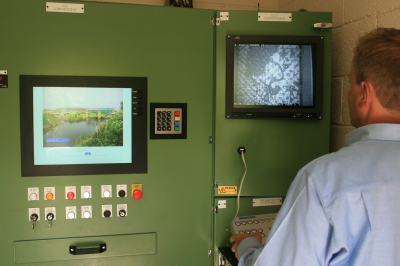The Environment Agency is using technology to discover the secrets surrounding the life of the baby eel on one of England’s best known elver rivers – the River Parrett in Somerset.
Elvers – juvenile eels (or “glass eels†when unpigmented) – have already been making their way over a new elver pass built by the Environment Agency during refurbishment of a flood defence structure at Oath Lock on the River Parrett in Somerset.
The peak period when elvers migrate upstream is usually March to May – since then, CCTV cameras installed above the lock have filmed baby eels wriggling up the pass giving them access to the network of rhynes and ditches on the Somerset levels and moors.
A recently commissioned report revealed the eel populations have been in decline nationally and internationally. The report used data collected by the Wessex ecological appraisal and fisheries teams, who are now investigating other barriers which may prevent eels from migrating upstream and where further elver passes could be built.
The camera is capable of recording the images at night when most elvers are running.
‘These images will enable us to collect data on the numbers and size of migrating elvers, the seasonality of their migrations and how environmental factors such as tide, moon-phase, rainfall and water temperature affect their movement,’ said Andy Don for the Environment Agency.
 The camera installation forms part of a wider investigation into the status of the eel population across the Somerset, and Bristol Avon catchments. This was undertaken on behalf of the Environment Agency by a national expert.
The camera installation forms part of a wider investigation into the status of the eel population across the Somerset, and Bristol Avon catchments. This was undertaken on behalf of the Environment Agency by a national expert.
Oath Lock marks the tidal limit of the river Parrett. Each spring elvers (juvenile eels) migrate upstream into freshwater.
‘The findings showed eel stocks across the catchment have declined and the escapement of adult eels back to sea is probably below the 40% European target but the population is relatively stable since the mid 1990’s with no evidence of imminent collapse,’ said Pete Sibley, who managed the investigation for the Environment Agency.
Simple measures, such as putting structures in place to help eels get past weirs and other obstructions and installing special traps around the region to check how many glass eels are migrating upstream, are being taken by the Environment Agency.
‘Eels have a fascinating and unique life-cycle, in which our rivers in the South West play an important role. Without them, there would be a serious impact on river ecology. They are also an important source of food for species such as the bittern and otter.’
All European eels start life in the only known spawning ground in an area of the Sargasso sea, south of Bermuda. The larvae follow the Gulf Stream and North Atlantic Drift to return to Europe metamorphosing into glass eels when they reach the continental shelf.
Glass eels are attracted to freshwater and enter British rivers in the spring. Glass eels become pigmented and metamorphose into elvers, spending a number of years in rivers and lakes, feeding and growing.
After an average of six years for males and nine years for females, eels begin to mature, stop feeding and turn silver. Silver eels swim downstream towards the sea to begin the long migration of 5,500 km back to the Sargasso Sea, where they will spawn and die.
On September 27th the Environment Agency, Wessex Area are hosting a meeting of experts in Bridgwater to discuss the findings of the investigation. The meeting will include CCTV film of elvers ascending the pass at Oath.









